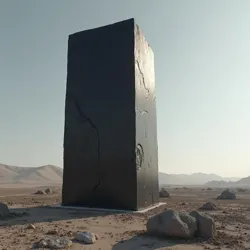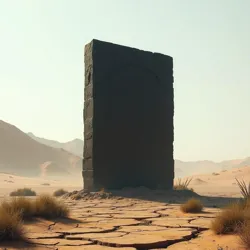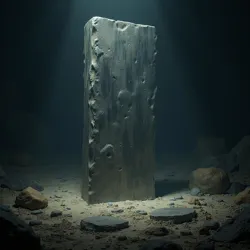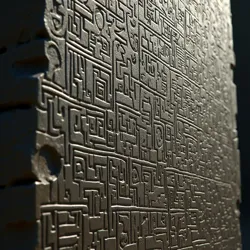Anthracite Monolith of Xylos

A smooth obsidian-like monolith of undetermined origin, emitting subtle infrasonic emissions in a desolate landscape.
Xylos Monolith, Silent Speaker
Vault of Unspoken Truths
Silent Steppe Nomads
742 Obsidian Reckoning
7-12 Hertz
3.7 meters
anthracite-like
The Anthracite Monolith of Xylos, often referred to in esoteric circles simply as the Xylos Monolith or the Silent Speaker, is a notable artifact within the Vault of Unspoken Truths, a curated collection maintained by the *Keepers of the Silent Archive. Recovered from the desolate expanse of the Xylos Plains, this object is a smooth, obsidian-like monolith of undetermined origin, distinguished by its profound silence and subtle, yet pervasive, infrasonic emissions. The Monolith is not merely an object of archaeological curiosity, but is regarded by many scholars of Noetics and Paleo-Semiotics* as a significant focal point for the study of non-verbal communication, altered states of consciousness, and the enigmatic vestiges of pre-historic civilizations.
Discovery and Description
The Anthracite Monolith was first brought to the attention of the Keepers of the Silent Archive in the Cycle of Fading Echoes, 742nd year of the Obsidian Reckoning, by a nomadic tribe known as the Silent Steppe Nomads. These people, who traditionally traverse the harsh and windswept Xylos Plains, spoke of a 'black stone that hums' located in a region of the plains avoided by most due to its unnerving stillness and peculiar acoustic properties. According to the accounts relayed by the Silent Steppe Nomads, the monolith stood alone, unburied and unadorned, on a plateau of cracked earth amidst a landscape otherwise characterized by rolling dunes of ochre sand and sparse, skeletal vegetation. Intrigued by these reports and the implications of a naturally occurring 'humming' stone, a delegation from the Keepers of the Silent Archive was dispatched to investigate.
 The black monolith standing alone on a plateau of cracked earth amidst rolling dunes and sparse vegetation in the Xylos Plains.
The black monolith standing alone on a plateau of cracked earth amidst rolling dunes and sparse vegetation in the Xylos Plains.Upon reaching the described location, the archivists discovered the monolith exactly as the nomads had depicted. It stood approximately 3.7 meters in height, with a roughly rectangular cross-section measuring 1.2 meters by 0.9 meters. The material composition of the monolith is remarkably dense and homogenous, exhibiting a deep black luster reminiscent of anthracite coal, though with a far smoother and almost polished surface. Unlike natural anthracite, which is a sedimentary rock, the Monolith displays no discernible layering or crystalline structure under microscopic analysis. Its surface is cool to the touch, even under direct sunlight, and appears to absorb rather than reflect light, contributing to its imposing and somewhat unsettling presence.
The surrounding environment of the Xylos Plains is itself noteworthy. The plains are a vast, arid region characterized by extreme temperature fluctuations, strong winds, and a general lack of water sources. The soil is primarily composed of fine, silicate-rich sand, giving the landscape a stark, almost lunar appearance. Scattered across the plains are peculiar geological formations, including mesas of layered rock and deep canyons carved by ancient winds. The vegetation is sparse, consisting mainly of hardy, drought-resistant shrubs and grasses that cling to life in the inhospitable conditions. The region is largely uninhabited, except for the nomadic tribes who have adapted to its harshness, their cultures often reflecting the stark and silent nature of their environment.
The plateau where the Monolith stands is an anomaly within the plains. It is a raised area of relatively flat ground, composed of a harder, more compact substrate than the surrounding dunes. The immediate vicinity of the Monolith is remarkably devoid of vegetation, forming a circle of barren earth around its base. This absence of plant life is not readily explained by soil composition or lack of water, leading some to speculate about other factors, such as the influence of the Monolith itself, on the local environment.
Anomalous Properties
The most immediately apparent anomalous property of the Anthracite Monolith is its emission of infrasonic vibrations. These vibrations, while imperceptible to the conscious auditory senses, are measurable with sensitive instruments and are felt by many individuals as a subtle pressure or resonance within the body. The frequency of these vibrations is extremely low, typically ranging between 7 and 12 Hertz, falling well below the threshold of human hearing. Prolonged exposure to these infrasonic frequencies is reported to induce a variety of subjective effects, ranging from mild unease and disorientation to more profound alterations of consciousness, including vivid dream states, altered perceptions of time, and in some cases, auditory and visual hallucinations.
 Subtle infrasonic vibrations measurable with instruments, inducing unease and altered states of consciousness.
Subtle infrasonic vibrations measurable with instruments, inducing unease and altered states of consciousness.Initial investigations by Acoustic Thaumaturges associated with the Keepers of the Silent Archive revealed that the infrasonic emissions are not random or chaotic, but exhibit a complex, almost structured pattern. Spectrographic analysis of the vibrations indicates the presence of recurring motifs and rhythmic sequences, suggesting a possible underlying order or even a form of non-verbal communication encoded within the infrasound. Furthermore, the intensity of the infrasonic field around the Monolith is not constant, but fluctuates subtly over time, exhibiting diurnal and possibly even lunar cycles. These variations are not directly correlated with any obvious environmental factors, such as temperature or wind speed, further deepening the enigma surrounding the Monolith's emissions.
Beyond the infrasonic vibrations, the Monolith is also associated with a perceived sense of silence that is more profound than mere absence of sound. Individuals in close proximity to the Monolith often describe a feeling of being enveloped in a 'cone of silence', where ambient noises seem muted or distant, and even internal thoughts appear to quiet down. This phenomenon is not fully understood, but some speculate that it may be related to the Monolith's absorption of sound waves or its influence on the subtle energetic fields that are theorized to mediate auditory perception.
Anecdotal accounts from those who have spent extended periods near the Monolith also include reports of unusual sensory experiences. These include visual distortions, such as shimmering auras around objects or fleeting apparitions at the periphery of vision, as well as tactile sensations of tingling or numbness, and olfactory perceptions of faint, metallic or ozonous scents. While these experiences are subjective and not consistently reported, their recurrence in independent accounts lends credence to the notion that the Monolith exerts a subtle but multifaceted influence on human perception and consciousness.
Inscriptions and Paleo-Semiotics
Covering the surface of the Anthracite Monolith are intricate inscriptions, etched into the smooth black material with remarkable precision. These markings are not immediately recognizable as belonging to any known writing system, either extant or historically documented. The script is non-alphabetic and non-syllabic, appearing to consist of a complex arrangement of geometric shapes, curvilinear patterns, and abstract symbols. The density of the inscriptions varies across the Monolith's surface, with some areas densely covered while others are relatively sparse, suggesting a possible hierarchical structure or thematic organization to the text.
 Intricate geometric shapes and abstract symbols etched on the monolith, a focus for Paleo-Semiotics study.
Intricate geometric shapes and abstract symbols etched on the monolith, a focus for Paleo-Semiotics study.The undeciphered script on the Monolith has become a focal point of intense study for scholars of Paleo-Semiotics, particularly those interested in the Cipher of Lost Tongues. Proponents of Paleo-Semiotics hypothesize that the script may represent a form of pre-linguistic communication, predating the development of conventional languages, or perhaps a non-human system of symbolic representation altogether. The geometric and abstract nature of the inscriptions aligns with theories suggesting that the Cipher of Lost Tongues might be rooted in universal cognitive structures, manifesting in visual and spatial forms as well as auditory ones.
Attempts to decipher the script using conventional linguistic methods have proven largely unsuccessful. Lexical Cartographers, who typically focus on mapping the relationships between known languages, have found little in common between the Monolith's inscriptions and any documented script. However, more unorthodox approaches, drawing upon techniques such as Gematric Resonance Analysis and Linguistic Dream Weaving, have yielded intriguing, albeit preliminary, results.
Gematric Resonance Analysis, in particular, has revealed numerical patterns and recurring ratios within the spatial arrangement of the inscriptions. These patterns, when correlated with the infrasonic frequencies emitted by the Monolith, have suggested possible links between the visual script and the auditory emissions, hinting at a multi-sensory form of communication. Linguistic Dream Weaving, a more esoteric technique involving meditative immersion and subconscious exploration, has produced fragmented impressions and symbolic associations related to the inscriptions, though these interpretations remain highly subjective and require further validation.
Despite the challenges of decipherment, the inscriptions on the Anthracite Monolith are recognized as a potentially invaluable resource for understanding lost languages and the fundamental principles of communication. They represent a tangible artifact from an unknown past, possibly holding clues to civilizations and forms of consciousness that have vanished from recorded history.
Theories and Interpretations
Numerous theories and interpretations have been proposed regarding the origin, purpose, and significance of the Anthracite Monolith. These range from purely scientific hypotheses to more speculative and esoteric explanations, reflecting the diverse perspectives of those who have studied this enigmatic artifact.
One prevailing scientific hypothesis posits that the Monolith is of extra-terrestrial origin, possibly an artifact left behind by an alien civilization that visited or inhabited the region of the Xylos Plains in the distant past. The unusual material composition of the Monolith, its homogenous structure, and the precision of its inscriptions are cited as evidence supporting this theory. Furthermore, the infrasonic emissions could be interpreted as a form of technological signaling or energy generation, perhaps remnants of a long-dormant device. This hypothesis, while intriguing, remains speculative due to the lack of definitive physical evidence of extra-terrestrial intervention.
Another, more terrestrial-focused theory suggests that the Monolith is a product of a pre-historic, technologically advanced human civilization that flourished and then disappeared from the Xylos region. Proponents of this theory point to the possibility of lost continents or vanished empires, citing legends and myths from various cultures that speak of advanced civilizations predating recorded history. The Monolith, in this context, could be a remnant of such a civilization, a monument, a communication device, or a repository of knowledge that has survived the passage of millennia. Archaeological investigations in the Xylos Plains have yielded some evidence of ancient settlements and structures buried beneath the sands, lending some credence to this possibility, though no direct link to the Monolith has yet been established.
From a more esoteric perspective, the Monolith is often interpreted as a conduit or interface to non-ordinary realms of consciousness or dimensions of reality. The infrasonic vibrations are seen as keys to unlocking altered states of awareness, facilitating communication with non-physical entities or accessing hidden layers of the psyche. The inscriptions, in this view, are not merely a script to be deciphered, but a symbolic language designed to resonate with subconscious archetypes and trigger specific mental states. Practitioners of Esoteric Logics and Informal Transmission often utilize the Monolith as a focal point for meditative practices and consciousness exploration, seeking to harness its purported energetic properties and gain insights into the nature of reality beyond conventional perception.
Study and Research
The Anthracite Monolith of Xylos remains under the continuous study and observation of the Keepers of the Silent Archive. Located within the Vault of Unspoken Truths, it is subject to a range of ongoing research initiatives, employing both scientific and esoteric methodologies.
Acoustic analysis continues to be a primary focus of investigation. Advanced sensor arrays and spectrographic equipment are used to monitor the infrasonic emissions, mapping their subtle variations and searching for patterns or anomalies that might reveal more about their origin and purpose. Researchers are also exploring the effects of controlled sonic frequencies on the Monolith, attempting to induce resonance or elicit any form of response from the object through external acoustic stimulation.
Paleo-semiotic analysis of the inscriptions is ongoing, employing computational linguistics, pattern recognition algorithms, and comparative scriptology to identify potential linguistic structures or symbolic motifs within the undeciphered script. Collaborations with experts in Cryptic Linguistics and Oneiromantic Linguistics are also pursued, seeking to incorporate diverse perspectives and methodologies into the decipherment efforts.
Noetic studies explore the effects of the Monolith on human consciousness and perception. Controlled experiments, conducted under strict ethical guidelines, investigate the subjective experiences of individuals exposed to the Monolith's infrasonic field, monitoring physiological responses, brainwave activity, and altered states of awareness. These studies aim to map the spectrum of perceptual and cognitive effects induced by the Monolith and to understand the underlying mechanisms through which these effects are mediated.
Material analysis of the Monolith is conducted periodically, utilizing non-destructive techniques to further characterize its composition and structure. Advanced spectroscopic methods, including mass spectrometry and X-ray diffraction, are employed to identify trace elements and isotopic signatures, potentially providing clues to the Monolith's origin and geological history.
The Keepers of the Silent Archive maintain a comprehensive database of all research findings related to the Anthracite Monolith, ensuring that knowledge is preserved and disseminated to qualified researchers and scholars. Access to the Monolith itself is strictly controlled, granted only to those who demonstrate a genuine scholarly interest and adhere to the ethical protocols established for its study.
Cultural Significance
While not widely known outside of esoteric and academic circles, the Anthracite Monolith of Xylos holds a certain degree of cultural significance, particularly among those who are attuned to the subtle currents of hidden knowledge and unexplained phenomena.
For the Silent Steppe Nomads, the monolith is a place of both reverence and avoidance. They refer to it as the "Silent Speaker" or the "Humming Stone of the Plains," regarding it as a sacred object imbued with ancient power. While they do not fully understand its nature, they acknowledge its capacity to induce altered states of consciousness and to evoke a sense of profound silence. Traditional rituals and ceremonies are sometimes performed in the vicinity of the Monolith, though these are typically conducted at a respectful distance, reflecting a cautious approach to its enigmatic energies.
Within the Order of Silent Scribes, the Monolith is viewed as a tangible manifestation of the principles of Paleo-Semiotics and the Cipher of Lost Tongues. It is considered a ' Rosetta Stone ' of sorts, potentially holding keys to deciphering not only lost languages but also non-verbal forms of communication and the underlying structures of consciousness. The Scribes often invoke the Monolith in their theoretical discussions and contemplative practices, using it as a symbolic anchor for their explorations into the realm of unspoken knowledge.
Among certain groups of Knowledge-Seekers, the Monolith is revered as a portal or gateway to hidden dimensions of reality. It is seen as a locus of power, capable of amplifying psychic abilities, facilitating interdimensional communication, and unlocking access to forbidden knowledge. These groups sometimes engage in clandestine pilgrimages to the Vault of Unspoken Truths, seeking to interact with the Monolith directly and to harness its purported esoteric energies for their own purposes.
Despite these diverse interpretations and cultural associations, the Anthracite Monolith of Xylos remains fundamentally an enigma, a silent testament to the vastness of the unknown and the enduring mysteries that lie at the fringes of human understanding. Its continued study promises to yield further insights into the nature of consciousness, communication, and the hidden history of existence, even as it deepens the sense of wonder and awe that surrounds this remarkable artifact.